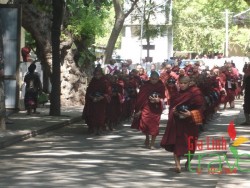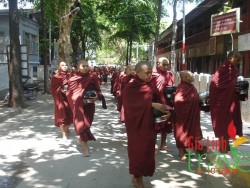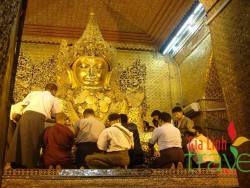Myanmar Religion and Beliefs
Myanmar Religion and Beliefs
Myanmar Religion and Beliefs Myanmar Religion and Beliefs In Myanmar, majority of the population are Buddhist, Theravada Buddhism is professed widely. Buddhism reached Myanmar around the beginning of the Christian era, mingling with Hinduism (also imported from India) and indigenous animism. The Pyu and Mon kingdoms of the first millennium were Buddhist, but the early Bamar peoples were animists. According to traditional history, King Anawrahta of Bagan adopted Buddhism in 1056, importing scriptures and monks from the Mon kingdom of Thaton in the south of the country. The religious tradition created at this time, and which continues to the present day, is a syncretalist mix of what might be termed ‘pure’ Buddhism (of the Sri Lankan or Theravada school) with deep-rooted elements of the original animism or nat-worship and even strands of Hinduism and the Mahayana tradition of northern India. Religious intolerance or discrimination on grounds of religion is non-existence in the Union of Myanmar throughout it’s long history. The main religions of present day Myanmar are Buddhism (89.20%), Christianity (5.05%), Muslims (3.78%), Hindus (0.55%), and Animism (1.27%) and other faiths such as Bahai Sikhs, Lipian fujianhal, Chinese, etc.(0.61%). Theravada Buddhism flourishes in Myanmar .With reference to stone inscriptions, palm leaf inscriptions and court chronicles tell us that Buddhism arrived in Myanmar not once but many times. The first arrival of Buddha Sasana The first arrival of Buddha Sasana was associated with the legend of the Shwe Dagon Pagoda. In accordance with this legend, Buddhism arrived in Myanmar in the lifetime of Buddha. In the Maha Sakarit year 103,while the Buddha. was in a phalasamm apatti meditation at the foot of Rajayatana Lin Lun tree in the Uruvela Forest near the Nerajara River, two merchant brothers Taphussa and Bhallika of Ukkalapa village of Ramannadesa came to worship the Buddha .The brothers offered the Buddha honey cakes and the Buddha preached the Dhamma to them. At their request the Buddha gave them eight sacred hairs of His Head as His relics to venerate. On their return home, they enshrined the Sacred Hairs in a ceti (pagoda) they built on the hill then called Tampaguta. That ceti was we now call Shwedagon Pagoda. This legend is mentioned in the Shwedagon stone inscription, set up by King Dhammazedi (AD 1472-1492) of Hanthawaddy Kingdom. The second arrival of Buddha Sasana In the Maha Sakarit year 111 , in the 20th Vasa of Buddha, Arahat Maha Thera Shin Gavempti entreated the Buddha to visit Thaton (Sudhammapura) in the Kingdom of Ramannnadesa. The people in that place become Buddhists after hearing the Dhamma. The third arrival of Buddha Sasana In the Maha Sakarit year 123 in the 20th Vasa of the Buddha, Maha Punna came and requested the Buddha to visit Sunaparanta Vaniccagama. When Buddha came to that place with 500 disciples, a monastery built of s The fourth arrival of Buddha Sasana When the Third Buddhist symbol was held during the regime of Emperor Asoka in Buddhist Era 235, foreseeing that the Buddha Sasana would spread to far off places and flourish there, Buddhist missionaries were dispatched to nine countries and nine places. Maha Thera Sona and Uttara accompanied by three arahats came to Suvannabhumi ( Thaton ) in Ramannadesa to carry out missionary work there. The fifth arrival of Buddha Sasana In the Buddhist Era 930 or A.D.386(circa) during the reign of King Mahanama of Sri Lanka who was a contemporary of King Thiligyaung of Bagan of Myanmar Mahar Thera Buddhaghosa who was a native of Gotha village in the Kingdom of Rajagahan came to Sri Lanka at the invitation of his mentor Maha Thera Revata. Mah Thera Buddhaghosa resided in Maha Vihara and he translated into Magadha, Tipitaka written Sri Lankan language. He brought to King Dhamapalla of Thaton in Ramannadesa his translated work. That is the arrival of the Buddha Sasana in Myanm Arrival of written Tipitaka in Tampadipa ( Bagan ) Buddha Sasana flourished in the Pyu City Kingdoms. By virtue of the artifacts excavated from archaeological sites such as Sri Kestra, Beikthano, and Hanlin show that at that time Mahayana Buddhism co-existed with Theravada Buddhism. Other places where Buddha Sasana flourished were Rakhine Vesali and Ramanna Desa. When Anawrahta became king in A.D. 1044, he was intent upon purifying Buddhism which was prevalent in Bagan. After he met Venerable Shin Arahan and achieved Tipitaka from Thaton Theravada Buddhism flourished in Myanmar. Other Religions Among non-Buddhist Myanmar citizens, 1.21% are animist, Christian 5.06%, 3.78% Muslim and 0.51% are Hindu. Most of the Muslim and Hindu, as well as many of the Christians, are of Indian descent. Majority of the tribal minorities are animists, where as there are some Christians among the tribal minorities. Islam reached Myanmar at approximately the same time, but never gained a foothold outside the geographically isolated seaboard running from modern Bangladesh southwards to the delta of the Ayeyarwady (modern Rakhine, known previously to the British as Arakan, and an independent kingdom until the 18th Century). The colonial period saw a tremendous influx of Muslim (and Hindu) Indians into Yangon and other cities, and the majority of Yangon’s many mosques and temples owe their origins to these immigrants. Christianity was brought to Myanmar by European missionaries in the 19th Century. It made little if any headway among Buddhists, but has been widely adopted by non-Buddhists such as the Karen and Kachin. The Chinese contribution to Myanmar’s religious mix has been slight, even non-existent, but several traditional Chinese temples were established in Yangon in the 19th Century when large-scale Chinese migration was encouraged by the British. Since approximately 1990 this migration has resumed in huge numbers, but the modern Chinese immigrants seem to have little interest in religion. Some more isolated indigenous peoples in the more inaccessible parts of the country still follow traditional animism. The Roman Catholic Church, Myanmar Baptist Convention and the Assemblies of God of Myanmar are the largest Christian denominations in Myanmar. Myanmar allows complete freedom of religious expression, and there appear to be no inter-religious tensions as such (although there are ethnic tensions, particularly between the dominant Bamar and the descendants of Indian migrants, which can find religious expression). Nevertheless, the current regime’s nationalistic policy of Bama hsan-jin, which considers Buddhism a key element of Burmese-ness, does provide a systemic bias in favour of Buddhists in terms of preferment in the armed forces and other State structures.


andal wood was offered to the Buddha to reside. Namanta Naga and his friend Hermit came to pay homage to the Buddha and requested to leave some kind of his Representative for them to worship. Thus, the Buddha left two footprints, one at the foot of the Minbu Hill Range and the other on a little higher up on the hill. These Buddha footprints are well known far and wide as Shwe Set Taw( literally Golden Footprints).
ar in the form of written tipitaka.
